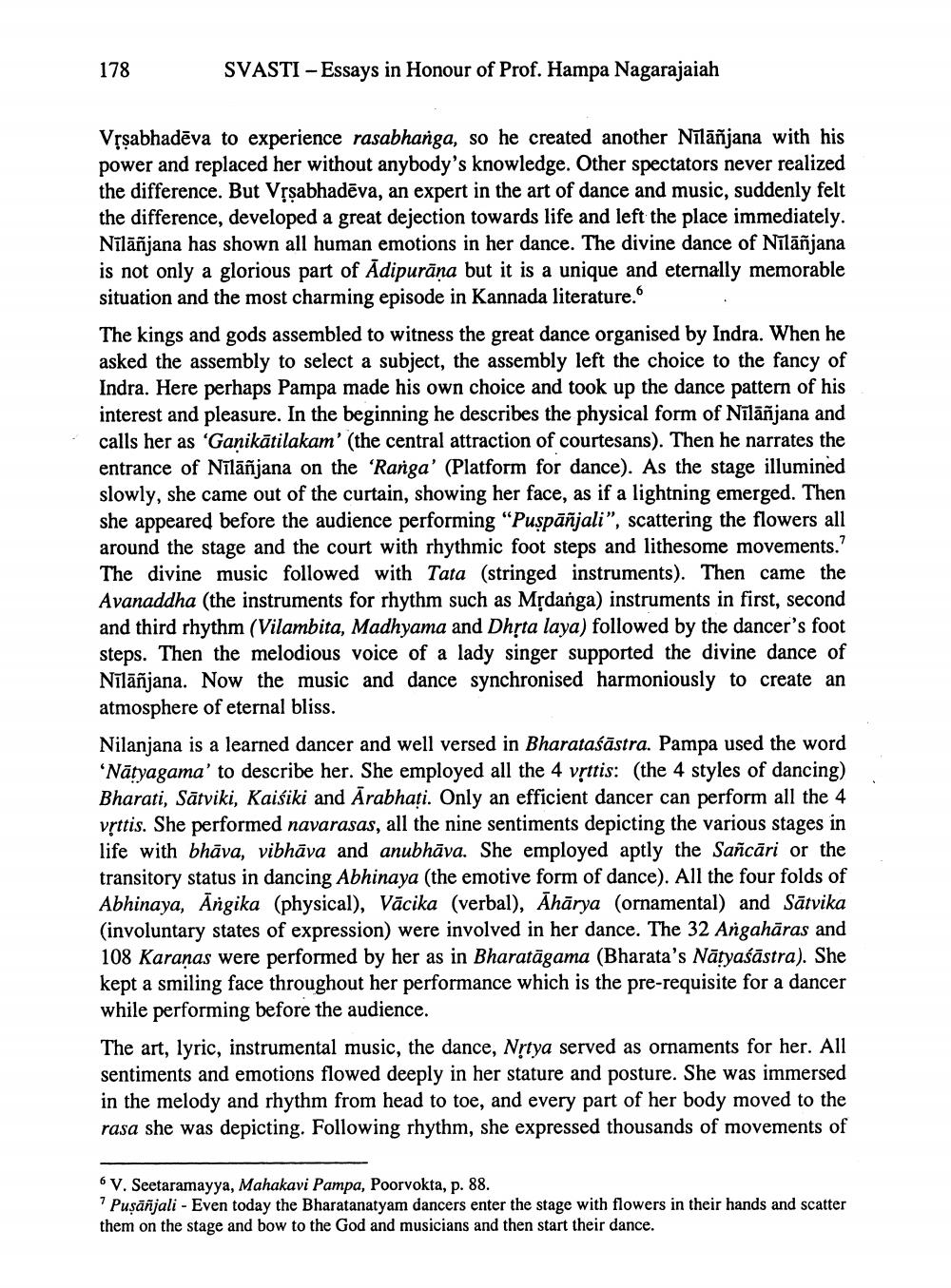________________
178
SVASTI - Essays in Honour of Prof. Hampa Nagarajaiah
Vrsabhadēva to experience rasabhanga, so he created another Nīlāñjana with his power and replaced her without anybody's knowledge. Other spectators never realized the difference. But Vrsabhadēva, an expert in the art of dance and music, suddenly felt the difference, developed a great dejection towards life and left the place immediately. Nīlāñjana has shown all human emotions in her dance. The divine dance of Nīlāñjana is not only a glorious part of Adipurāna but it is a unique and eternally memorable situation and the most charming episode in Kannada literature. The kings and gods assembled to witness the great dance organised by Indra. When he asked the assembly to select a subject, the assembly left the choice to the fancy of Indra. Here perhaps Pampa made his own choice and took up the dance pattern of his interest and pleasure. In the beginning he describes the physical form of Nīlāñjana and calls her as 'Ganikätilakam' (the central attraction of courtesans). Then he narrates the entrance of Nīlāñjana on the 'Ranga' (Platform for dance). As the stage illumined slowly, she came out of the curtain, showing her face, as if a lightning emerged. Then she appeared before the audience performing "Puspāñjali”, scattering the flowers all around the stage and the court with rhythmic foot steps and lithesome movements.? The divine music followed with Tata (stringed instruments). Then came the Avanaddha (the instruments for rhythm such as Mşdanga) instruments in first, second and third rhythm (Vilambita, Madhyama and Dhrta laya) followed by the dancer's foot steps. Then the melodious voice of a lady singer supported the divine dance of Nīlāñjana. Now the music and dance synchronised harmoniously to create an atmosphere of eternal bliss. Nilanjana is a learned dancer and well versed in Bharataśāstra. Pampa used the word 'Nātyagama' to describe her. She employed all the 4 vrttis: (the 4 styles of dancing) Bharati, Sātviki, Kaisiki and Arabhati. Only an efficient dancer can perform all the 4 vrttis. She performed navarasas, all the nine sentiments depicting the various stages in life with bhāva, vibhāva and anubhāva. She employed aptly the Sañcāri or the transitory status in dancing Abhinaya (the emotive form of dance). All the four folds of Abhinaya, Angika (physical), Vācika (verbal), Ahārya (ornamental) and Sātvika (involuntary states of expression) were involved in her dance. The 32 Angahāras and 108 Karanas were performed by her as in Bharatāgama (Bharata's Nātyaśāstra). She kept a smiling face throughout her performance which is the pre-requisite for a dancer while performing before the audience. The art, lyric, instrumental music, the dance, Nrtya served as ornaments for her. All sentiments and emotions flowed deeply in her stature and posture. She was immersed in the melody and rhythm from head to toe, and every part of her body moved to the rasa she was depicting. Following rhythm, she expressed thousands of movements of
6 V. Seetaramayya, Mahakavi Pampa, Poorvokta, p. 88.
Puşāñjali - Even today the Bharatanatyam dancers enter the stage with flowers in their hands and scatter them on the stage and bow to the God and musicians and then start their dance.




